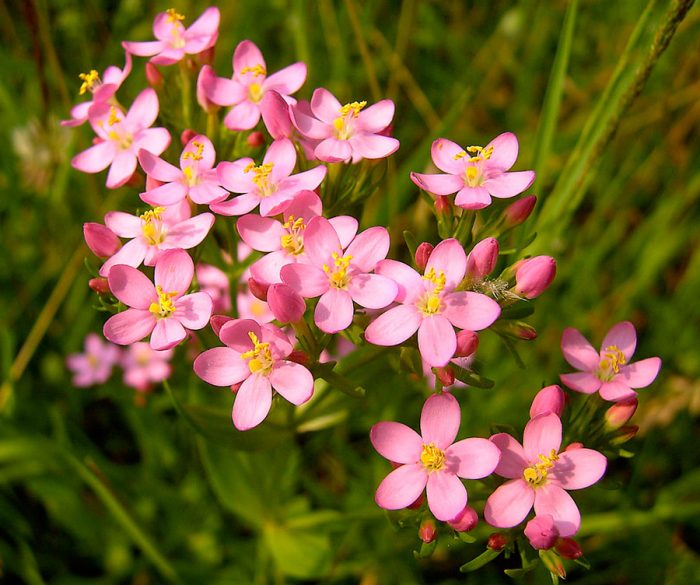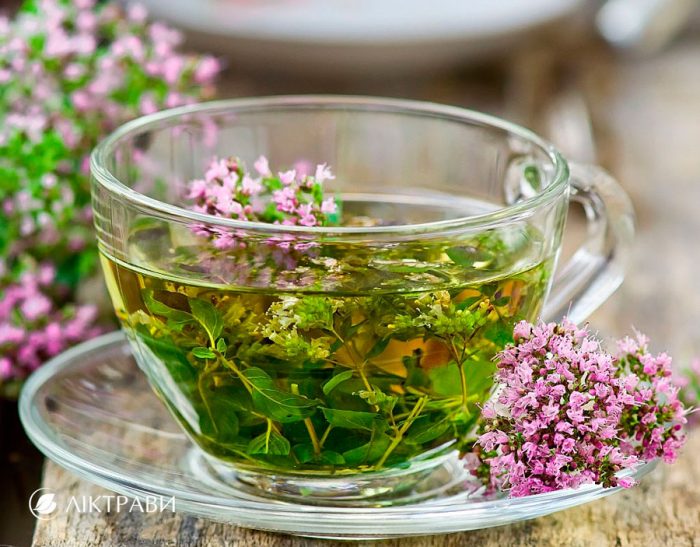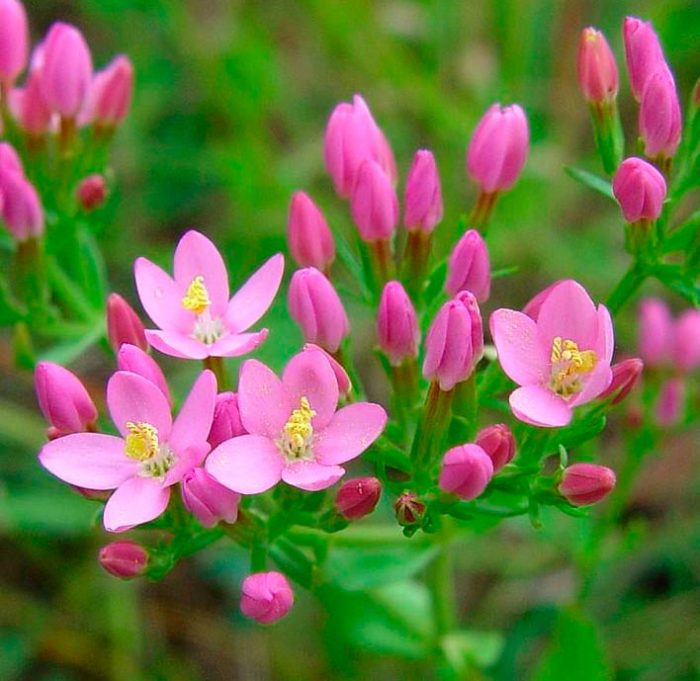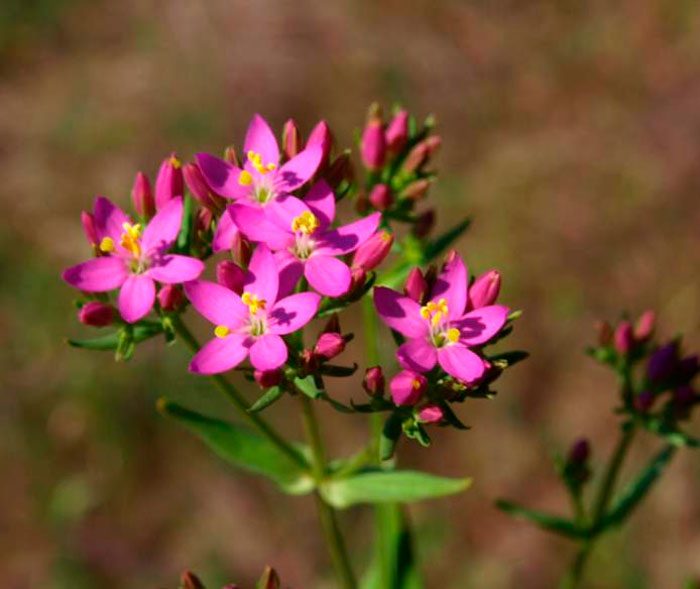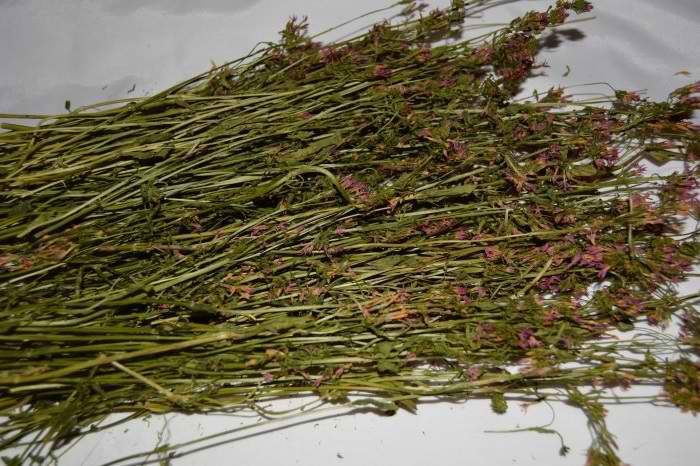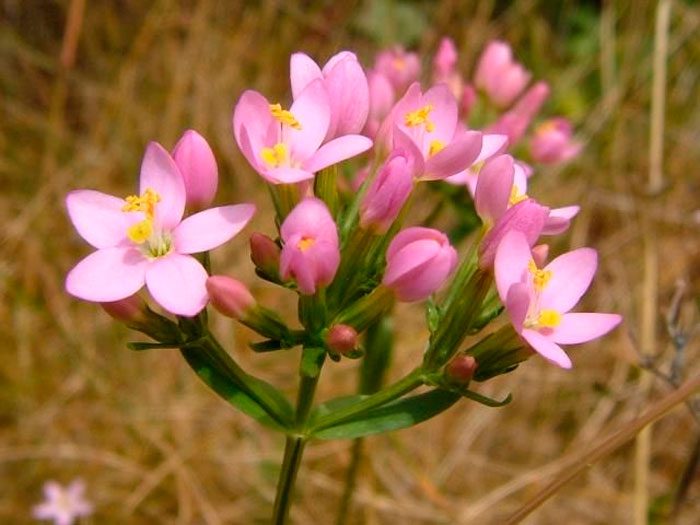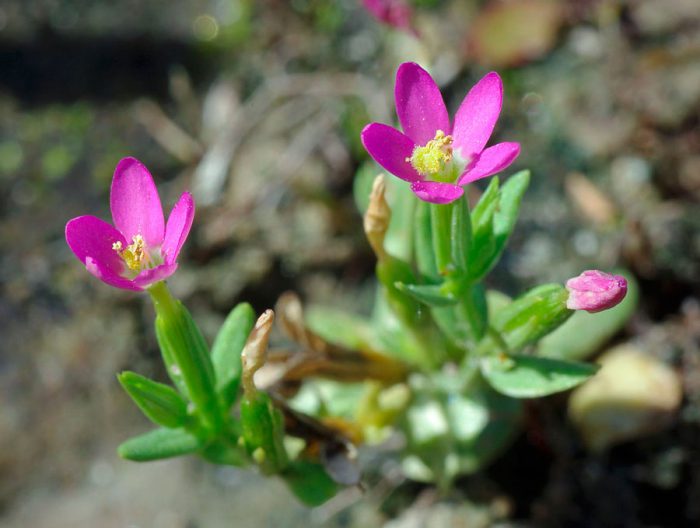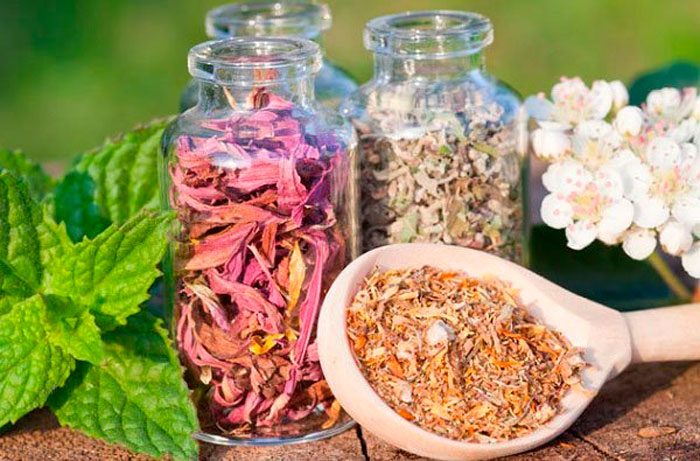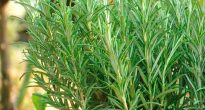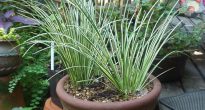The herbaceous plant centaurium (Centaurium) is a member of the gentian family. This genus unites about 20 species. Under natural conditions, representatives of this kind can be found in areas with a subtropical and temperate climate of Eurasia, Australia, as well as North and South America. On the territory of Russia, such a plant is popularly called the spool, thousandth, gold-thousander, spool grass and hearthorn. The centaury contains medicinal substances, thanks to which it is considered a medicinal plant.
Content
Features of the centaury
Centaury is an annual or perennial herb, its stems can be branching or simple. Stem-embracing or sessile leaf plates are entire and oppositely located. The double-beam corymbose inflorescence consists of yellow, pink or white flowers. Flowering begins in June or August. The fruit is a bivalve box, which has one or two nests, and many seeds ripen in them.
Back in the 13th century, it became known about the medicinal properties of this plant. To date, the preparations of such a herbaceous plant are part of the pharmacological groups of appetite regulators, as well as antihelminthic and laxative agents under the trade name "centaury grass".
How to grow a centaury in a garden
Most often, as a medicinal plant, gardeners cultivate the common centaury species. For its cultivation, experts recommend choosing an open and well-lit area, and such grass can also be grown under trees in partial shade. The centaury plant grows best on sandy loam or loamy soil, while the groundwater must lie at a depth of at least 200-300 centimeters.
The seed, which must be harvested in nature, is combined with sand in a ratio of 1: 5. Sowing seeds is carried out in the spring in dug, rolled and moistened soil to a depth of 0.5 to 1 centimeter. The row spacing can vary from 0.45 to 0.6 meters.For several days, the surface of the site must be covered with agrofibre or film, which will allow the seedlings to appear much faster than usual. After the first plants appear, the shelter should be removed. After they grow up a little, they must be thinned out.
Many gardeners grow such a crop through seedlings and then transplant it outdoors. Sowing seeds for seedlings is carried out in the last days of February or the first - in March. Planting seedlings in open ground should be carried out in the last days of May, while the distance between the bushes should be 5-10 centimeters.
Care for centaury
Centaury requires the same care as many other garden crops. With prolonged drought, the bushes must be watered, they also need to ensure timely weeding and loosening of the soil surface between the rows. And if necessary, the centaury is protected from harmful insects and diseases.
Such grass is characterized by slow growth, in this regard, weeding is carried out more often than usual, otherwise the seedlings may be drowned out by weeds. In the first year of growth, only a small leaf rosette will form in the bushes. The collection of medicinal raw materials begins to be carried out from the second year of growth, while experienced gardeners recommend sowing this grass for 2 years in a row, however, different areas are used for this. In the first year, it will be necessary to collect medicinal raw materials from the first bed, and in the second - from the second plot, next year - again from the first, and so on.
Diseases and pests
Centaury is very resistant to diseases and harmful insects. However, in some cases, pests from crops growing nearby can move to it. If it rains too often in the summer, then such a plant will rot.
If, nevertheless, the bushes get sick, they must be treated, resorting exclusively to folk remedies, while using chemical preparations containing harmful substances in their composition is not recommended, since they can accumulate in the grass.
Collection and storage of centaury
The centaury herb has medicinal properties. The collection of raw materials is carried out at the beginning of flowering, this must be done in time until the basal leaf rosette begins to turn yellow. Shoots must be cut at a height of 10 to 15 centimeters from the soil surface. The grass is tied in bunches, which must be dried by tying it under the roof of an attic or other room, which must be cool, shady and well ventilated. Drying of medicinal raw materials should not be carried out in direct sunlight, since because of this the grass burns out, and together with the presentation it loses some of its medicinal properties. For drying, the bundles need to be made small enough, since large ones dry for a very long time. Dried raw materials are stored for storage in cardboard boxes, paper bags or fabric bags, then they are put away in a cool, dark and dry place, where it can be stored for 1.5-2 years.
Types and varieties of centaury
Common centaury (Centaurium erythraea)
Or small centaury, or umbellate centaury, or centuria, or centauri, or seven-strong. This type is the most popular among gardeners. The height of the tetrahedral erect stem can vary from 0.1 to 0.5 m. In the upper part it is branched. In the first year of growth, a basal rosette is formed at the bush, consisting of lanceolate leaf plates with short petioles. Crossly opposite sessile leaf plates can have an oblong-ovate or lanceolate shape, and also longitudinal veins. Shield-shaped inflorescences are composed of deep pink flowers. They include tubular cups, 5 sepals, and a corolla with an almost flat limb.Flowering is observed in June-September, while in August the fruits begin to ripen, which are capsules reaching 10 millimeters in length. The fruits contain brown small, round seeds.
Beautiful centaury (Centaurium pulchellum)
This species is much less common in natural conditions. The height of such an annual plant is about 15 centimeters. In comparison with other species, the formation of a basal rosette does not occur in the bushes. Stem leaf plates are opposite. The five-membered flowers are pink in color, and in length they reach 0.8 centimeters, their disclosure occurs only in sunny weather. Bloom is observed in July – September. The fruit is a capsule that reaches 1.9 cm in length, it contains very small seeds of a dark brown color. This species was listed in the Red Book of Latvia, as well as several regions of Russia and Ukraine. The aerial part of the bush (foliage, shoots and flowers) is used as a medicinal raw material.
Centaury properties: harm and benefit
Medicinal properties of centaury
The composition of the medicinal raw material of centaury includes alkaloids, essential oils, flavone glycosides, phytosterols, vitamin C, potassium, calcium, magnesium, zinc, copper, chromium, selenium, manganese, iron, resins, mucus, ascorbic acid and organic acids. Due to this composition, this plant has an anti-cancer, antispasmodic, hepatoprotective, antiviral, tonic, antiarrhythmic and laxative effect. This herb is recommended for non-healing wounds, inflammatory diseases, fragility of the walls of blood vessels, chronic sinusitis, and even with painful menstruation, toxicosis of the first half of pregnancy, uterine bleeding and for the recovery of the uterus after childbirth.
Recipes
Infusion of the herb centaury is used for heartburn, to improve digestion, with flatulence and other problems of the digestive system. To prepare it, you need to combine 10 grams of dry herb with 1 tbsp. freshly boiled water. When the mixture is infused, strain it. The remedy is drunk three times a day before meals, 1 tbsp. l.
The broth will help get rid of worms. To prepare it, you need to combine 1 gram of wormwood with the same amount of centaury grass and 1 tbsp. freshly boiled water. The mixture is heated in a water bath. The cooled broth is filtered and drunk in the morning on an empty stomach. You need to be treated for at least 7 days.
An alcoholic tincture of this herb is taken for poor digestion, diabetes, heartburn and constipation. To prepare it, you need to take 1 tbsp. l. dry herb, which should be crushed to a powdery state. The herb is then combined with 30 milligrams of rubbing alcohol. The container must be tightly corked and removed for 1.5 weeks in a dark and cool place. The strained tincture should be drunk within 30 minutes. before a meal, 20-30 drops, which are combined with water.
Contraindications
Such a medicinal herb is contraindicated for those who have individual intolerance. It also cannot be used by people suffering from gastritis with highly acidic acidity, diarrhea, duodenal ulcers and stomach ulcers. If the drug is taken for too long or in case of an overdose, poisoning and indigestion may develop. Centaury is not recommended for people with a tendency to obesity, as this plant stimulates the appetite.
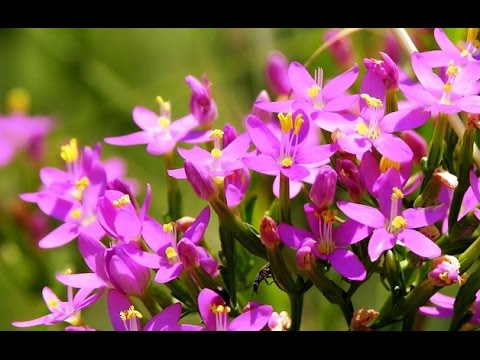

Watch this video on YouTube

